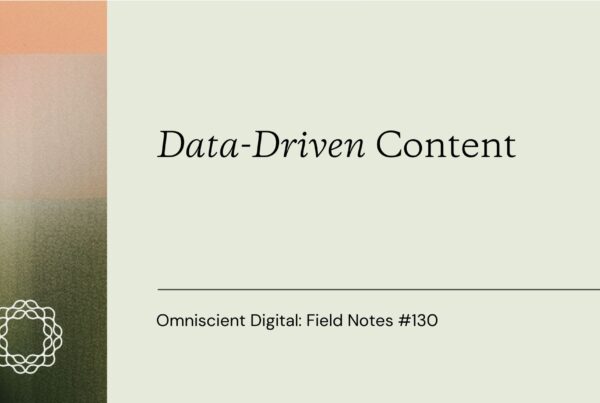
How do you do something you haven’t done before?
As founders, marketing leaders, and well-working professionals in general, we’re faced with this almost every day.
A new project we haven’t done before. A new person we haven’t worked with. A new role we were promoted into.
The instinctive question is, “What’s the best way to do this?”
But that might be the wrong question.
A better set of questions is, “What information do I have available? What’s the best way to go about this project with the information available to me?”
Below I’ll share the framework I used when I was faced with those situations in my roles at HubSpot and People.ai and continue to face every day as we build Omniscient Digital.
This is the process I’ve followed for multiple projects in my career:
- Rebuilding a product integration and go-to-market strategy for HubSpot to acquire freemium users
- Producing a sales course with sales leaders at HubSpot in partnership with Coursera
- Creating a financial strategy for Omniscient Digital
Here’s the framework:
1. Gather context.
Who’s involved in or impacted by the project/problem and is likely to have an opinion? Who has thought about the project before? Speak to those people. It’s rare that you’ll work on something that no one at the company has ever thought about before.
You don’t have to implement their ideas. By speaking with them, you’ll develop an idea of what’s important and what the project could look like. This is often a better starting point than starting from a blank slate.
2. Speak to others who have done it before.
This is the toughest part because it requires proactively reaching out to people–often strangers–and putting ourselves out there to learn from others. It’s also the most fruitful.
When I was head of growth at People.ai, I reached out to other people in the same role at similar companies to learn about how they approached the challenges I was running into. This went beyond building growth channels to learning how to communicate what we do across a company.
They often provided me with new perspectives that I hadn’t considered before. These conversations sometimes went contrary to the opinions of people at my company which further refined my thinking on how I might go about a project.
3. Spend an hour creating a plan based on that information.
Yes, one hour. Any more than that and you’re probably overthinking it and the perfectionist part of us feels like it’s making progress by creating a “perfect plan.”
There’s no such thing as a “perfect” plan (the best laid plans…). Aiming to create a “perfect” plan is actually procrastination in disguise. This is what is referred to as meta-work. It feels like work, but you aren’t actually producing any tangible business result or learning.
Block out an hour or if it makes you feel better, a day, to draft up a plan.
Then go back to those same people from steps 1 and 2 and get feedback from them. Be aware that you might inadvertently draw out the planning period infinitely due to too much feedback. People will have opinions and questions about everything. They’ll have an idea of how you should do it even though they probably haven’t done it themselves!
Time blocks the feedback and set an expectation of how long you’ll accept feedback and when you’re going to start executing the plan.
Here’s an example script: “Please share feedback on this within the next 48 hours. That will let me take your feedback into consideration when I start executing this plan on Monday. I’ll continue to iterate on this plan as I work through it and learn what works and what doesn’t and share my learnings with you.”
Get the feedback. Implement what you think makes sense based on the context and opinions you’ve developed. Then move on.
4. Execute the plan knowing it won’t go smoothly.
This is when things get tough. You have to actually start executing and realizing that things just aren’t going according to plan.
Almost all of the most important learnings happen when you actually start executing.
You learn what does and doesn’t work.
Turns out that the marketing channel doesn’t perform as well as you expected.
Or turns out that the integration you wanted to build is a lot more complicated than you expected.
Or turns out people aren’t interested in partnering with you.
These are all learnings and data points so you can do better next time.
Avoid the finisher’s paradox.
5. Iterate.
Take what you learned from starting to execute the plan and iterate. Knowing what you now know, what parts of the plan should change? Is it still a valid project that’s worth investing time and resources to do?
Hopefully, the next time you run into a new challenge, this framework can help you get through it.
Recommended Reads
1. Speed as a Habit – Speed is a competitive advantage. This is a core reason why startups are able to take market share away from incumbents. The key takeaway from the above is that when you’re faced with taking on something you haven’t before, you need to avoid analysis paralysis and take action.
2. Meta-work: Why you’re always busy with nothing to show for – This gets into the behaviors that result in spending time on “work” that feels productive but actually isn’t. It gave me something to reflect on and I think it’s helpful for us to regularly ask ourselves if what we’re working on is truly productive or just activity disguised as work.
3. Podcast: “How to build a business that lasts” – Thomas Smale shares his experience advising on hundreds of business acquisitions and the most common traits he finds in businesses that last.


